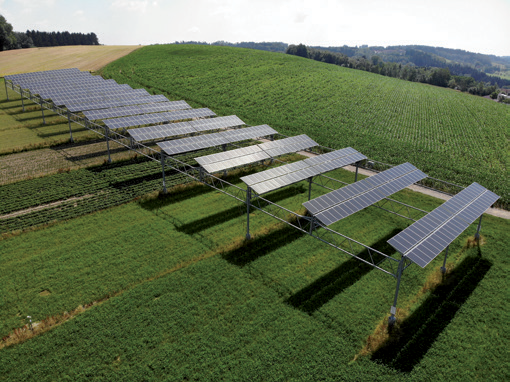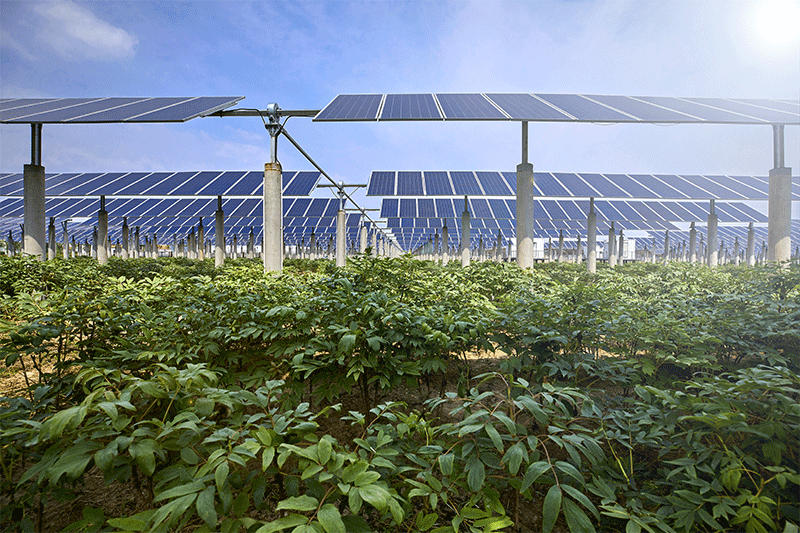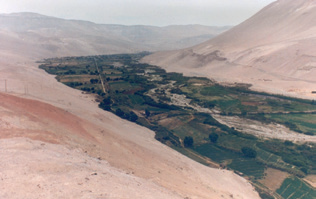Growing in the shade of solar power
Whether it’s in temperate climates or more arid regions, co-locating crops and solar panels is a win-win solution.
Written by:
JÖRAN BEEKKERK VAN RUTH, ENGIE LABORELEC
STIJN SCHEERLINCK, ENGIE LABORELEC
ROB KURSTEN, ENGIE BENELUX
CLAIRE DU COLOMBIER, ENGIE SOLAR
Read the PDF article here
Special issue in partnership with ENGIE Research
in the framework of its Key Program Smart Food and Agriculture.
April 2020

All around the world, photovoltaic systems have become a key element in the energy transition and yet some highly urbanised countries, such as Belgium and the Netherlands, lack the necessary space to install large solar power plants. In this context, wouldn’t it make sense to use the land more wisely?
One solution would be to combine agricultural activity and solar power production on the same plot of land, a concept known as agrivoltaics (a word coined by combining agriculture and photovoltaics). ENGIE BENELUX has taken up the challenge and is implementing a large-scale project of this type in the Netherlands that aims is to install a 45-megawatt solar farm combined with a crop-growing activity by 2021.
CELERY OR RASPBERRIES?
The first phase of the project consists of a one-hectare field trial to test different options and gain the necessary experience that will enable the deployment of the demonstrator over 50 hectares. Several questions need to be answered, such as what to plant. What’s best, celery or raspberries? The crop must be marketable, but be able to grow in the shade. Another question involves choosing between classic or bifacial solar panels and deciding on their configuration, i.e. what is the optimal density of PV panels to produce enough electricity, without blocking too much sun from the underlying ground? To answer these questions, ENGIE is working with a local partner, Green Meteor, which originally specialised in building structures to protect crops against the hail or the sun. This partnership is also beneficial in that it forges links with the horticultural sector, which is vital for the proper conduct of the project.
Do the PV arrays affect yields? The findings of the APV-RESOLA project, conducted in Germany by the Fraunhofer Institute ISE in 2018 show that agrivoltaic installations are capable of achieving satisfactory agricultural production. Some crops are quite tolerant to shade and can adapt to a reduction in photo-synthetically active radiation (the amount of light available for photosynthesis, i.e. situated in a range of wavelengths between 400 and 700 nanometres) without significant yield loss. The results therefore vary depending on the amount of shadow caused by the solar panels.
As part of the APV-RESOLA project, an experimental field planted with potatoes (see figure on opposite page) was partially covered with solar panels, resulting in a 30% decrease in the annual amount of sunlight received. As a result, potato yield increased by 3%! The ove-rall result can be expressed as a land equivalent ratio, in this case the LER is 186%, i.e. 103% potato efficiency compared to the reference yield for the same area and 83% relative pho-tovoltaic production efficiency.
Whereas potatoes seem to benefit from shade, this is not the case for all plants. In the same conditions, clover production decreased by 8% illustrating that the choice of crop type is crucial!
THE GLOBAL HISTORY OF AGRIVOLTAICS
The idea of co-locating photovoltaics and agriculture was first suggested in 1981 by Adolf Goetzberger and Armin Zastrow and it has progressed in Japan since 2004 under the impetus of Akira Nagashima. Many types of crops such as citrus fruits, cucumbers, rice and vines can benefit. The technique has now spread to various countries around the world: China, India, Malaysia, Austria and Chile etc. In 2017 in Vietnam, the Fraunhofer Institute ISE deployed a pilot agrivoltaic system on a shrimp farm in the Mekong Delta.

ENCOURAGING BIODIVERSITY
The synergies between agriculture and photovoltaic go far beyond crops and energy efficiency. Solar farms can benefit local biodiversity, whilst creating a habitat that is vital to the survival of pollinators. In the United States for example, ENGIE NORAM has planted local plant species on its solar farms and joined forces with various stakeholders, such as the National Renewable Energy Laboratory (NREL) in Colorado and the University of Minnesota Bee Lab, to create habitats for pollinators including bees, as well as to support biodiversity on a national level. One particular example is the InSPIRE project through which the NREL is trying to quantify the environmental and economic benefits of planting native and other beneficial vegetation at solar sites.
Another example is a project under development in Hawaii in which ENGIE has joined forces with Agicon LLC to identify possible synergies between photovoltaics and agriculture. One of its recommendations is to use an indigenous native shrub, the Psydrax odorata as a windbreak.
In France, ENGIE Green has also deve-loped five solar projects that integrate beehives and flowering plants as a way of supporting biodiversity.
Can agrivoltaics be useful elsewhere than in temperate regions? To answer this question, let’s head off to the Atacama Desert in Chile, which is difficult to beat as far as sunshine and heat are concerned! High solar irradiance is of course good news for PV power production, although excessive temperatures and dust can negatively affect performance. Heat and lack of water are however not usually ideal conditions for crop growth.

ENGIE is envisaging the development of an agrivoltaic
project in Chile’s Arica Province (photo of Lluta Valley).
GROWING IN THE DESERT
But that’s exactly where agrivoltaics comes in: the shade provided by solar PV arrays allows crops to thrive in favourable microclimatic conditions (higher soil moisture and lower ambient temperatures). If a source of water is available, water can be pumped to irrigate plants using locally produced green electricity and, even better, in these hot climates the vegetation planted under the PV panels tends to reduce the ambient temperature, thereby improving their performance.
At the end of the day, agrivoltaics in arid regions can provide local communities with unprecedented economic activity. Compared to installations in temperate regions, the potential gain in overall yield (solar and agri-cultural) is greater, mainly due to the significant increase in crop yields. ENGIE plans to develop a pilot project in partnership with farmers around the city of Arica in the Atacama Desert, one of the driest areas in the world.
Wherever crops and solar power come together, agrivoltaics is paving the way for smarter and more resilient agriculture. In each energy project, the possibilities of this combination must be studied at an early stage in order to make the most of the best available expertise and find optimal agricultural and energy solutions. Proof of the growing interest in agrivoltaics: the INRA and the Fraunhofer Institute ISE will be holding the first international conference on the subject in August 2020 in Perpignan.
References
Agrophotovoltaics : High Harvesting Yield in Hot Summer of 2018, institut Fraunhofer ISE, 2019.
H. Marrou, Co-locating food and energy, Nature Sustainability, vol. 2, pp. 793-794, 2019.
G. Barron-Gafford et al., Agrivoltaics provide mutual benefits across the food-energy-water nexus in drylands, Nature Sustainability, vol. 2, pp. 848-855, 2019.
R. Davis, Solar and pollinators : A photo essay, PV Magazine, 2019.